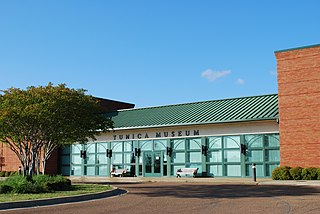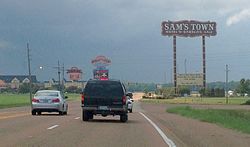
Tunica County is a county located in the U.S. state of Mississippi. As of the 2010 census, the population was 10,778. Its county seat is Tunica. The county is named for the Tunica Native Americans. Most migrated to central Louisiana during the colonial period.

DeSoto County is a county located on the northwest border of the U.S. state of Mississippi. As of the 2010 census, the population was 161,252, making it the third-most populous county in Mississippi. Its county seat is Hernando.

West Memphis is the largest city in Crittenden County, Arkansas, United States. The population was 26,245 at the 2010 census, ranking it as the state's 18th largest city, behind Bella Vista. It is part of the Memphis metropolitan area, and is located directly across the Mississippi River from Memphis, Tennessee.

Friars Point is a town in Coahoma County, Mississippi, United States. The population was 1,200 at the 2010 census, down from 1,480 in 2000.

Hernando is a city in and the county seat of DeSoto County, which is on the northwest border of Mississippi, United States. The population was 14,090 at the 2010 census, up from 6,812 in 2000. DeSoto County is the second-most-populous county in the Memphis metropolitan area, which includes counties in Tennessee and Mississippi.

Tunica is a town in and the county seat of Tunica County, Mississippi, United States, near the Mississippi River. Until the early 1990s when casino gambling was introduced in the area, Tunica had been one of the most impoverished places in the United States. Despite this economic improvement, Tunica's population continues to decline from its peak in 1970.

The Tunica-Biloxi Indian Tribe, formerly known as the Tunica-Biloxi Indian Tribe of Louisiana, is a federally recognized tribe of primarily Tunica and Biloxi people, located in east central Louisiana. Descendants of Ofo (Siouan-speakers), Avoyel, and Choctaw (Muskogean) are also enrolled in the tribe.

Downtown Memphis, Tennessee is the central business district of Memphis, Tennessee and is located along the Mississippi River between Interstate 40 to the north, Interstate 55 to the south and I-240 to the east, where it abuts Midtown Memphis.

Tunica Resorts is a census-designated place (CDP) in northern Tunica County, Mississippi, United States, north of the county seat of Tunica. The community is situated mostly between the Mississippi River and U.S. Route 61 along the border with Arkansas.The population as of the 2010 census was 1,910.
Mississippi Highway 304 (MS 304) is east-west state highway in the northwestern part of the U.S. state of Mississippi, running for 40.3 miles (64.9 km) as a four-lane freeway from U.S. Route 61 in Tunica Resorts to the Tennessee state line near Collierville. It is mostly concurrent with Interstate 69 (I-69) and Interstate 269 (I-269).

Area code 662 is the telephone area code serving the northern half of Mississippi, including the six counties that are part of the Memphis metro area. It also includes the cities which are home to the state's two largest universities, Oxford and Starkville.

Walls is a town located in northern DeSoto County, Mississippi, United States, near the Mississippi River, part of the larger region known as "The Delta", and known for its rich, dark soil. As it is in the upper northwest corner of Mississippi, it is in the Memphis, Tennessee metropolitan area. Its ZIP code is 38680. As of the 2010 census it had a population of 1,162, with an estimated population of 1,463 in 2018.
The proposed Interstate 69 (I-69) extension from Indianapolis southwest to Texas currently has a short piece completed in the U.S. state of Mississippi, south of Memphis, Tennessee. The south end is an at-grade intersection with the former route of MS 304 near Tunica Resorts, where Mississippi Highway 713 continues west to U.S. Highway 61, and the route continues north to the Mississippi state line. Much of the route overlaps Mississippi Highway 304, which intersects US 61 farther north than MS 713. MS 304 continues east from I-55, connecting to State Route 385 in Tennessee, forming part of the Interstate 269 Memphis outer beltway.
The Koroa were one of the groups of indigenous people who lived in the Mississippi Valley prior to the European settlement of the region. They lived in the northwest of present-day Mississippi in the Yazoo River basin.

The Tunica people were a group of linguistically and culturally related Native American tribes in the Mississippi River Valley, which include the Tunica ; the Yazoo; the Koroa ; and possibly the Tioux. They first encountered Europeans in 1541 - members of the Hernando de Soto expedition.

Mhoon Landing is an unincorporated community located on the Mississippi River in Tunica County, Mississippi, United States. It is approximately 6 miles (9.7 km) northwest of North Tunica and approximately 12 miles (19 km) southwest of Tunica Resorts.

The Tunica Museum is a museum in Tunica, Mississippi dedicated to the history of Tunica County. Founded in 1997 and funded by casino gambling revenues, it has 6,500 square feet (600 m2) of permanent exhibit space and 1,600 square feet (150 m2) of temporary exhibit space, which showcase historically aspects of the region including race relations, Native American settlements, and the daily life of residents. It offers self-guided tours and is free to enter.

Norfolk is an unincorporated community located in Desoto County, Mississippi, United States. Norfolk Landing, located a short distance west of Norfolk, was the community's port on the Mississippi River.

Brunswick is a ghost town in Warren County, Mississippi. Brunswick Landing, north of the community, was located directly on the Mississippi River.
Quigualtam or Quilgualtanqui was a powerful Native American Plaquemine culture polity encountered in 1542-1543 by the Hernando de Soto expedition. The capital of the polity and its chieftain also bore the same name; although neither the chief nor his settlements were ever visited in person by the expedition. Their encounters consisted of messages sent by runners and a three-day long canoe battle on the Mississippi River. Multiple archaeological cultures, archaeological sites, and protohistoric and early historic period Native American groups have been proposed by historians and archaeologists to identify the polity, but their identity will probably never be known with any degree of certainty.















